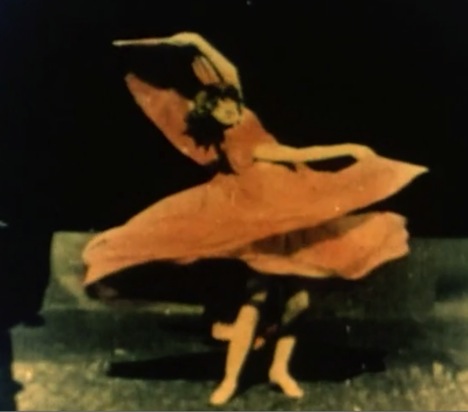[11] Anabelle Twirling (1897)

CARMODY: This girl opens like a magic flower in a wind
of changing colors. (pause) Don’t you think?
BLIGHT: I couldn’t hear a thing.
1
We crossed the bridge from San Francisco to Berkeley to see Bill T. Jones’s new choreography in a piece called Story/Time. Jones sat at a small table onstage, under a clock that counted down the seconds from 60 to 0, and read out one-minute-long stories in various styles, personal, political, philosophical. As he read a story, his dancers writhed and leaped and twirled and twisted and flew in a beautiful and fluid poem made of music and bodies. As the clock and story counted down to the end, those dancers moved off, and as he began to read a new story fresh dancers spilled onto the stage to create another painting in motion.
the dancers’ movements
come all the way to the edge
of speech, inventing
their alternative to words
in the air with their bodies
it is not ballet
no remembered language here
it’s all invented
as they go, as if learning
new letters for unheard sounds
dancing silently
no music, she makes her own
and we strain to hear
what the billowing fabric
says, what tune it is humming
2
Walt Disney’s animated movie Fantasia includes a sequence, “The Dance of the Mirlitons,”2 in which we first see widening and overlapping rings in the water of a pool where delicate flowers are floating down from the trees and into the water, pink flowers at first, then gold, and then blue. They turn and revolve in ballet unison to the music of Tchaikovsky’s Dance of the Reed Flutes, metamorphosing into dancer-flowers as a large white blossom drops among them, and the dance revolves in ever larger circles into the center of the pool, gracefully round and round, and then gently over a bubbling little waterfall, with the white flower the last reluctantly to go.
she dances alone
the music and the story
just out of her reach
but the flowers have a life
all their own; she’s living it
O, the dance circles!
endlessly, whirling upwards
down in another
outward circle, her sleeve ends
twirl into butterfly wings
she has been twirling
a century in silence
keeping the cosmic
rhythms that authenticate
the very idea of dance
3
If you were looking for the frontier between then and now, you could find it exactly where Turner’s seas and Constable’s clouds fail. They sought to capture on the stillness of canvas and in drying dollops of oil paint the vital movements of nature. The painter looks up and captures a vision of the moment and by the time he’s turned back to the canvas, the moment has moved on. Yet, we stand in front of his picture and imagine we see the winds high up on a whiff of cloud like a tress of woman’s hair, and need to wipe away the salt spray on our faces. But here with Annabella dancing, Thomas Alva Edison, in the most primitive of cinematography, and aiming for 46 frames per second, sped up the images of billowing silk till all we have to do is remind ourselves it isn’t real.
turn it all around
pretend images reflect
the poems we’ve written
and let imagination
make me a picture of this
they might meet mid-air
colored, curling, flying silk
scarves about to speak
and words experimenting
with polished accents of silk
no art can subsist
in the absence of its tools
art remains outside
of us, a mediated
thing. oh, right...there’s singing
Bio: Charles D. Tarlton
